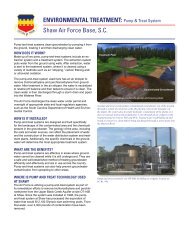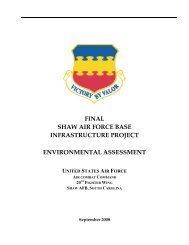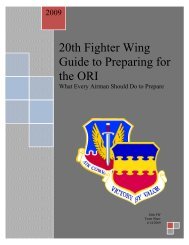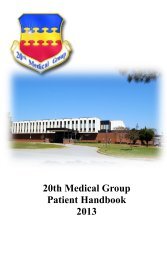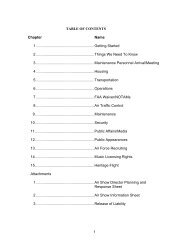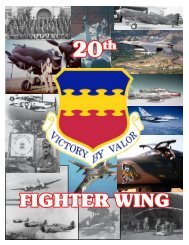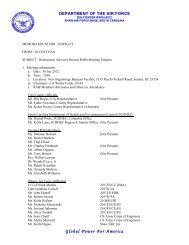HISTORY OF THE 20 FIGHTER GROUP - Shaw Air Force Base
HISTORY OF THE 20 FIGHTER GROUP - Shaw Air Force Base
HISTORY OF THE 20 FIGHTER GROUP - Shaw Air Force Base
You also want an ePaper? Increase the reach of your titles
YUMPU automatically turns print PDFs into web optimized ePapers that Google loves.
In January 1943 the group moved to March Field, California, where it acquired its P-38 Lightning aircraft. At March the<br />
group would once again proceed with training new members but this time the results of the training would deploy to<br />
England as the <strong>20</strong> th FG to write its pages of history.<br />
To Europe in “Luxury” on the Queen Elizabeth<br />
Eight months later, on 11 August 1943, the personnel of the <strong>20</strong> th departed California aboard three trains and arrived at<br />
Camp Miles Standish, Massachusetts, five days later. From this European staging area the members of the <strong>20</strong> th<br />
embarked on the HMS Queen Elizabeth and departed for the United Kingdom on <strong>20</strong> August 1943. If the members of the<br />
<strong>20</strong> th had expected a typical Queen Elizabeth pleasure cruise, they were sorely disappointed. The ship had been refitted to<br />
accommodate over 19,000 men. Staterooms designed for two or three people had <strong>20</strong> to 30 bunks double and triple<br />
stacked for officers and enlisted men. In addition to these conditions, enlisted personnel also served shifts of 24 hours on<br />
deck, followed by 24 hours below deck. This doubled the number of personnel the cramped quarters could accommodate.<br />
Due to its high speed, the HMS Queen Elizabeth traveled unescorted, despite the ever-present threat posed by German<br />
submarines. The five day trip across the Atlantic was reported as uneventful, except for long chow lines (two meals per<br />
day) and frequent boat drills. On 25 August 1943, HMS Queen Elizabeth dropped anchor and the men of the <strong>20</strong> th<br />
disembarked at the Firth of Clyde. From there they were transported to the docks at Greenock, Scotland, and then, by<br />
train, to their new home, King’s Cliffe <strong>Air</strong>field, North Hamptonshire, England. Fortune smiled on the 55 th FS at this time.<br />
Due to space restrictions they had to be stationed at RAF Wittering, about five miles from the rest of the group. The<br />
facilities at RAF Wittering were much superior to those at King’s Cliffe. The 55 th Squadron joined the rest of the group at<br />
King’s Cliffe in April 1944.<br />
King’s Cliffe<br />
Arriving at King’s Cliffe, the group faced the prospect of operating from one of<br />
the poorest airfields in England. The buildings were old and inadequate and<br />
airfield facilities were close to nonexistent. The only thing in abundance was<br />
poor weather and mud. Overcoming the initial shock of these conditions the<br />
group soon settled in and got on with the serious job of flying. The group was<br />
assigned to the Eighth <strong>Air</strong> <strong>Force</strong> throughout the war.<br />
Prior to the <strong>20</strong> th ’s arrival in theater, the Republic P-47 Thunderbolt served as<br />
the primary U.S. fighter aircraft in Europe. This aircraft was a formidable match<br />
for the German Luftwaffe (<strong>Air</strong> <strong>Force</strong>) fighters in air-to-air combat but lacked one<br />
important feature--range. Without sufficient range, the conduct of daytime<br />
bomber escort missions, first into Europe and then Germany itself, proved<br />
nearly impossible. That problem was perhaps best illustrated on 14 October 1943 when 60 of 293 unescorted bombers<br />
(<strong>20</strong> percent), dispatched against the ball bearing works in Schweinfurt, failed to return from their mission.<br />
The P-38 Era Begins<br />
With the arrival in Europe of the Lockheed P-38, the long<br />
range escort mission of the Eighth <strong>Air</strong> <strong>Force</strong> began in earnest.<br />
Initially, due to a lack of available aircraft the <strong>20</strong> th conducted<br />
operations as an attached component of the 55 th FG. Full<br />
group operations for the <strong>20</strong> th commenced in late December<br />
1943 when the group became fully equipped with P-38s.<br />
One of the early highlights of the group’s World War II exploits<br />
entailed the escort of a bombing mission into the Bordeaux<br />
area of France on 31 December 1943. This 1,300 mile round<br />
trip constituted the longest fighter escort mission to date. That<br />
distance, in fact, stretched the P-38s beyond their operational<br />
limits, forcing 17 of 31 aircraft to land at other bases due to<br />
insufficient fuel.<br />
P-38H of the 77 th FS in September 1943. Pilots<br />
simulate a “scramble” for this publicity shot as<br />
they wait to fly their first operational mission.<br />
P-38H of the 55 th FS based at RAF Wittering, England Aug 1943<br />
to Apr 1944 then King’s Cliffe, England until the end of the war.



